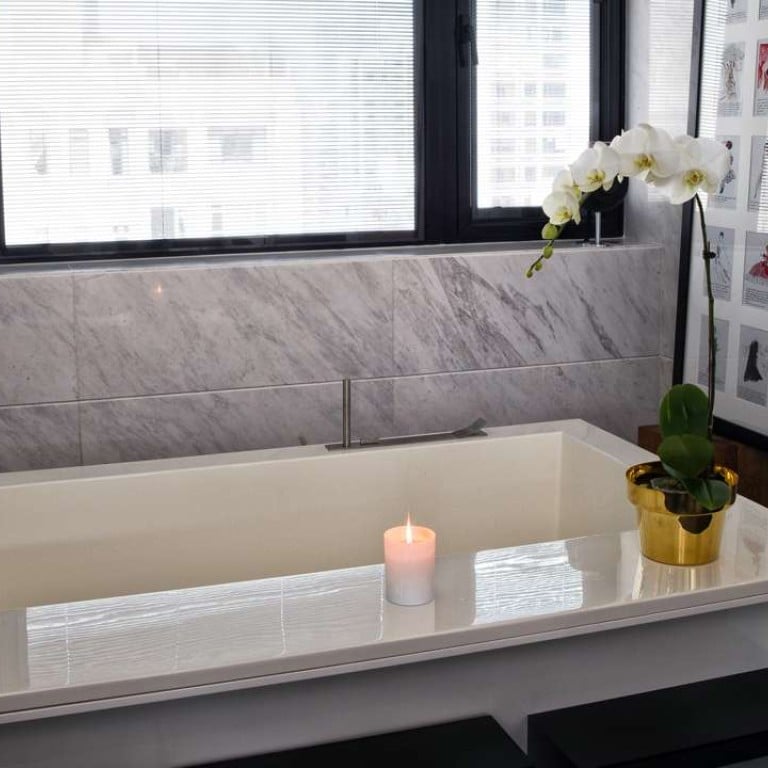
Hong Kong homeowners make bathtub their bathroom's crowning glory
Versatility, ease of use and practicality are the hallmarks of the latest designs. Stand-alone tubs are big, and showers are getting bigger
Bathtubs used to be simple things. They were attached to the wall. There was a shower head at one end. You pulled a curtain to keep water from going where it wasn’t supposed to.
But like many other aspects of home decor, tubs and showers have gone uptown.
“People want their tubs to be the masterpiece of the bathroom,” says Thomas Phan, principal owner of Lifestyle Fixtures in Huntington Beach, California. One of the most popular ways to achieve that aura is with a free-standing bathtub, which sits in a prominent place and doesn’t abut any wall. “A free-standing tub sits in the middle of the bathroom,” Phan says. “It says, ‘Look at me’.”
READ MORE: Spacious Hong Kong flat goes from traditional to futuristic
Clearly, you need some space for such a large hunk of plumbing hubris. But there are a variety of free-standing tub sizes now, so even smaller bathrooms can accommodate the look.
Another advantage of free-standing tubs, Phan says: “They’re easier to clean around.”

Free-standing tubs usually mean separate showers, and there are a couple of trends developing in that realm: size and accessibility.
READ MORE: Design tweak gives Hong Kong home flow – and plenty of storage
“Bigger showers are getting popular,” says Joel Warners, president of Faucets N’ Fixtures in Orange, California. “It’s part of the growing acceptance in our industry that people shower 85 per cent of the time. The shower shouldn’t be an afterthought or some small cubicle.”

Despite the challenge of space in Hong Kong, showers are also growing in size where possible, although making them bigger sometimes means getting rid of a bathtub. Chan Keng Siew, who built a two-person shower in Sai Kung, has no regrets about no longer being able to take long soaks. “We found that we were using the tub only a couple of times a year, so replaced it with a roomy shower enclosure with built-in bench,” she says. “It’s great sitting under the rain shower; we don’t miss the tub at all.”

Another trend sweeping bath and shower design is the concept of ageing in a place. “People want a shower and bath that are accessible and easy to use as they get older,” Warners says. “They want to stay in the same place rather than move and have to change their familiar home environment.” Some additions for the ageing owner include grab bars and permanent shower seats. And some showers are being made large enough to allow for a wheelchair.
For that reason, one concept that’s finding favour with older homeowners is the Roman shower. Designed without a door or even a rim to step over, it’s ideal for people who can’t use a regular shower. High-volume channel drains, a ceiling-mounted shower head that rains water down vertically and other tricks make the shower drain quickly and properly.
“It’s the best kind of shower for people with disabilities,” says Mehran Ghassemi, owner of Renaissance Kitchen, Bath & Flooring in Orange. “It’s best suited for homes with more area, though. They need a lot of space.”
The popularity of the Roman shower is more evidence of a move toward spa-style features in bathrooms – things that promote healthy living and good hygiene. Japanese soaking tubs, steam showers and air bathtubs are designed to improve the health and relax the frazzled spirit.

Phan says he has sold several Japanese tubs recently. He thinks they’re especially helpful for people who have difficulty sitting in a regular-shaped tub.
“The difference is that in a Japanese tub, you sit upright. They take up less floor space [than a regular tub] but they’re much deeper, almost like a hot tub. You can either install them raised on a pedestal with a small staircase or you can have them submerged so you step down into them.”
Clifton Leung, of Clifton Leung Design Workshop in Hong Kong, agrees. “They take up the same space for an ordinary shower but offer two functions: shower and tub,” he says of the 650mm-deep Japanese baths he often builds into Hong Kong bathrooms. Because space is often tight, he tries to incorporate the window ledge or, sometimes, a bay window so they can be part of the bath.

Another bathtub growing in popularity is the air bathtub. “Thermal hot air is forced into the tub through small openings,” Warners says. “It’s a great therapy for arthritic and joint pain and working [on] deep muscle tissue. And compared to a Jacuzzi tub, it’s easier to install, less prone to break, less noticeable, simpler and more hygienic.”
Warners says more than 90 per cent of his high-end tub sales are now air systems. Fewer than 10 per cent are jetted tubs – a huge change from a decade ago, when Jacuzzi ruled the home-bath world. It perfectly epitomises the sea change from complex and over the top to simple and tasteful that has characterised the latest bath trends.

“Ten years ago everything was the Tuscan look, with lots of oil-rubbed bronze. Finally, that trend is about dead,” Warners says. “Everything has moved to simpler lines and a cleaner look.”
Cleaner, and more natural and low-maintenance, too. “People like natural materials right now,” Warners says. He sees a trend toward concrete materials and, for tubs, metal and even stone. “It’s mainly because they want something that’s easier to maintain as well as being more timeless in its appearance.”
That’s why more durable finishes for fixtures are coming back, Warners thinks.
“Brushed nickel, chrome and the other big finish right now, aged brass – they’re all easier to take care of than the bronze look, which was popular but wasn’t the most durable finish.
“You shouldn’t spend hours just to make your bathroom look great. Who has the time?”
Tribune News Service

